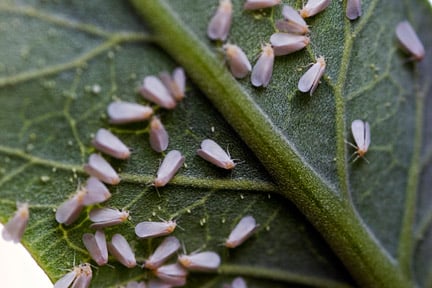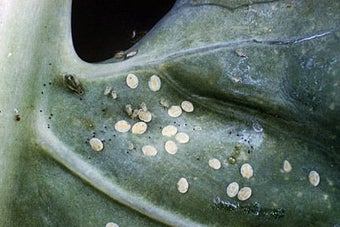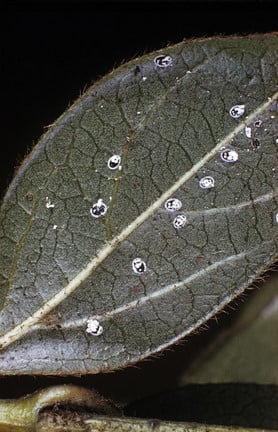
Quick facts
Common name - Glasshouse whitefly
Scientific name - Trialeurodes vaporariorum
Plants affected - Many house-plants and greenhouse plants
Main symptoms - Sticky honeydew on foliage, black sooty moulds, small white-winged insects
Most active - All year round
What is glasshouse whitefly?
Whiteflies are sucking true bugs (Hemiptera) in the family Aleyrodidae. The adults are typically white and fly up from host plants. There are around eight species found in Britain, some are restricted to a limited host range, others are found indoors on a wide range of plants.
Glasshouse whitefly can feed on many vegetables and ornamental plants grown in greenhouses as well as house-plants. These include: cucumber, melon, tomato, peppers, Chrysanthemum, Gerbera, Pelargonium, Fuchsia,Lantana, poinsettia and Verbena.
Outdoor plants can also host this whitefly especially in warm summers, however, note that whiteflies seen on brassicas, Viburnum tinus, honeysuckle, evergreen azalea and rhododendron are other species of whitefly specific to those plants.
Glasshouse whitefly thrives in warm conditions, which is why it is not usually a problem on outdoor plants. This insect is active all year round on houseplants and in greenhouses.
Symptoms
- It is relatively easy to see whiteflies on affected plants. When a plant is disturbed clouds of small white-winged insects, 1.5 mm (about 1/16 in) long, will fly up. This distinguishes whitefly from other insect such as aphids. White objects on the top surface of leaves are more likely to be aphid skins
- You may also see flat, oval, creamy white scale-like nymphs (sometimes called larva and pupa) on the underside of leaves. If these nymphs are black they have probably been parasitised by an Encarsia wasp and are dead
- Adult whitefly and nymphs excrete sticky honeydew which falls onto foliage, stems and fruits and allows the growth of black

Management
If you encounter this insect on indoor plants then please consult our page on indoor plants: sap feeders for indoor specific advice.
- Watch for signs of whitefly on new purchases as the insect is often first brought into a glasshouse on new plants. If possible quarantine new plants in order to give eggs and nymphs a chance to develop and be recognised
- Removing unwanted plants from the glasshouse can reduce the number of host plants for glasshouse whitefly
- Good will help to check the growth of
- Cleaning glasshouses in winter can help reduce overwintering populations
- An established method of control for glasshouse whitefly is to introduce tiny parasitoid wasps, Encarsia formosa, which prey on the whitefly scale nymphs. The parasitoid is available by mail order from the Biological control suppliers. It is important to introduce the parasitoid before plants are heavily affected as it cannot give instant control. Parasitised whitefly nymphs turn black so it is easy to monitor the progress of the control. Other predators such as the mite Amblyseius andersonii (egg predator) are sometimes available in addition to Encarsia
- Hang sticky yellow sheets (widely available from garden suppliers) above or among the plants to trap adult whitefly, this can help monitor whitefly activity rather than give control. Sticky traps often catch non-target organisms including parasitoid wasp predators so their use should be considered carefully
Downloads
Biological control suppliers (pdf document)
Biology
Glasshouse whitefly is a -sucking insect that breeds rapidly and produces many generations in warm greenhouse conditions. The adults and their whitish scale-like nymphs (also known as larvae and pupae) live on the underside of leaves where they feed on sap, weakening the plants. They lay greyish white cylindrical eggs either singly or in circles on the underside of the leaves.
Each female can lay more than 200 eggs. Males are rare and reproduction takes place without the need for . The eggs hatch into small crawler scale-like nymphs which crawl around for a while before they begin feeding and become immobile. The nymphs are a flat, oval shape, whitish-green in colour, and just over 1mm in length when fully developed. The final nymphal stage is called a pupa and the adult whitefly eventually emerges through a slit in the dorsal surface. The length of the life cycle varies according to the temperature. At 10ºC (50ºF) the life cycle takes several months, but can be completed in about three weeks at 21ºC (70ºF). The insect can remain active during the winter in an unheated greenhouse, provided suitable host plants are present. Glasshouse whitefly does not usually survive winter out of doors.
Image: © GWI/John Swithinbank. Available in high resolution at www.gardenworldimages.com











